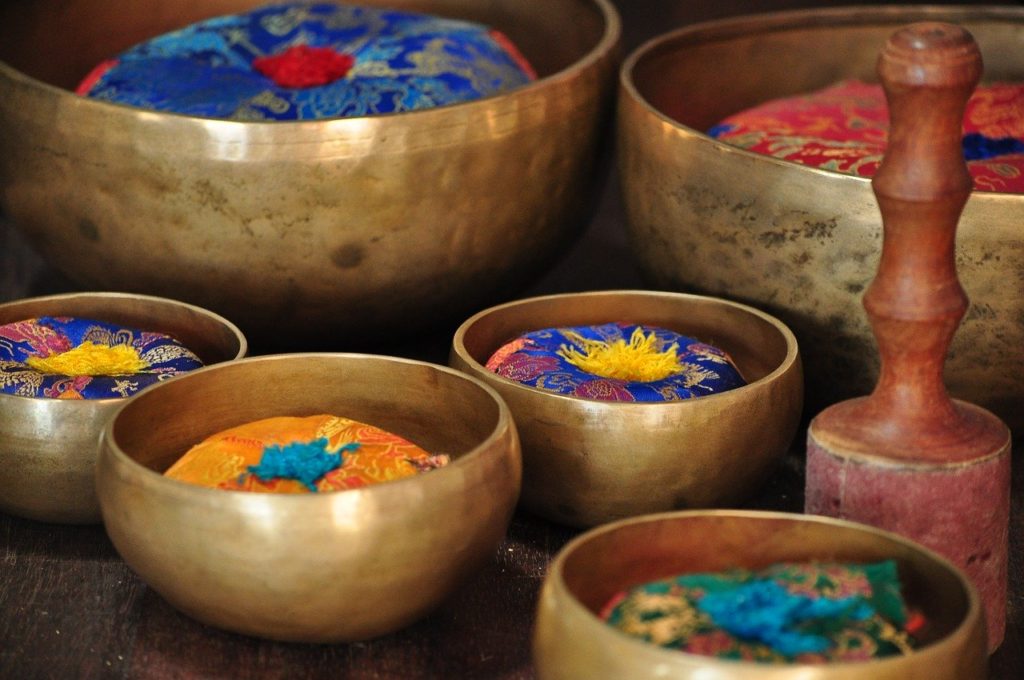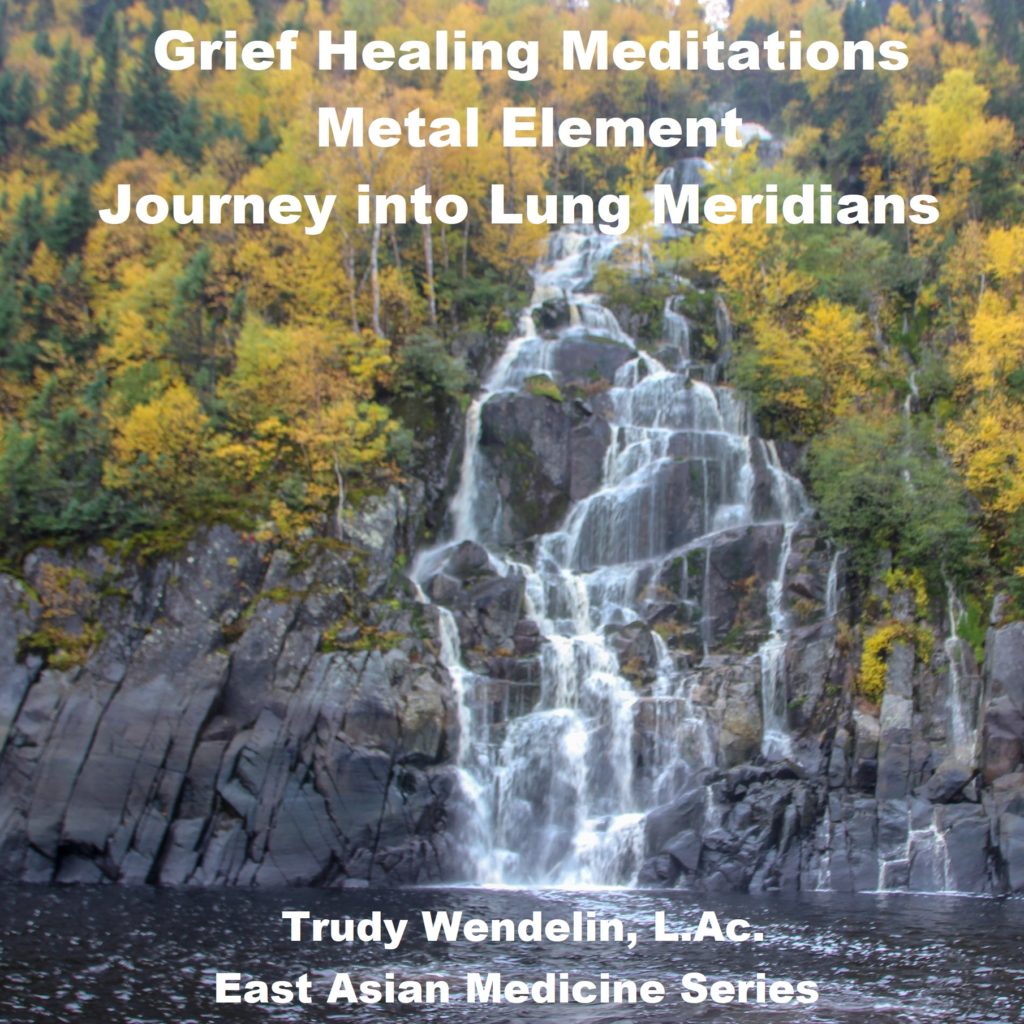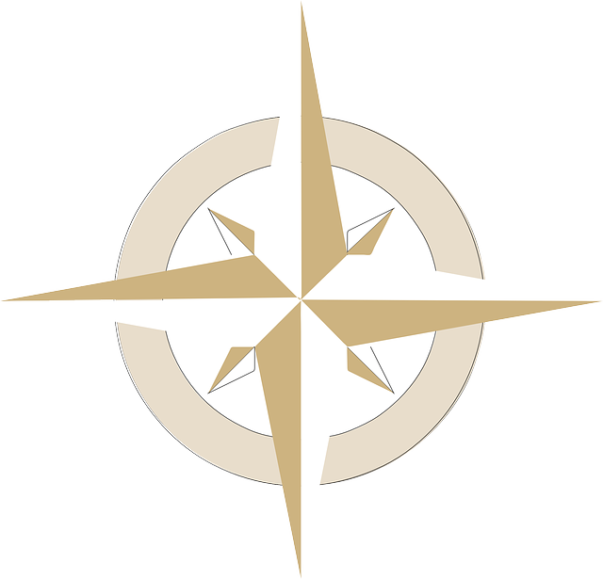The Metal Element of Feng Shui & East Asian Medicine corresponds with Autumn. It’s the ideal time for letting go emotional residue and anything else the body does not need. East Asian Medicine wisdom is a helpful guide on the best way to cleanse your whole being, attuned to the seasonal cycles. Autumn corresponds with the lungs and large intestine. Therefore, this is the best time to cleanse these organs. Also, it’s a good time to detoxify the mind and body’s toxic residue from emotional grief or sadness.
East Asian Medicine – Five Element System
East Asian Medicine rests on a foundation of 5 Element Theory, involving Wood, Fire, Earth, Metal and Water. A 5-phase theory interrelates these organic energies in our body and nature. In other words, this pentagram within, hosts a flow of energies that depict our personalities, emotions and health imbalances. Everyone has their unique energetic blueprint of 5 elements expressed through health patterns, and this can be a key factor in diagnosing for an East Asian Medicine Practitioner. Overall, this article is part of a 5 element series, focusing on the metal element for autumn. Here is a table that sums up all of the elements and some of their correspondences:
Five Elements’ Table of Correspondences

The interrelationships follow a flow in which each element feeds the next element and controls the second as depicted below. For example, Metal feeds water and controls wood and so on. Also, Metal is fed by earth and controlled by fire (think of melting).

Overall, we embody all five elements, however, many individuals express certain elements more strongly. For example, a Metal type would take on more traits of this element, being more analytical and resistant to change and letting go.
Metal Element of Feng Shui & East Asian Medicine – Lung/Large Intestine Meridians

In East Asian Medicine, the Metal element is one of the 5 Archetypes used in diagnosis. Certainly, human are out of balance with their essential blueprint. Therefore, understanding the baseline can give guidance for objective assessments, helping to eliminate judgement and encourage personal evolution. Also, the metal element corresponds with the 3 earthly branches of Autumn: Monkey, Rooster and Dog.
Metal’s symbol is the white tiger. Its western direction in feng shui ba-gua is corresponds with children, creativity and the future. Metal qualities include strength, independence, focus, intensity, righteousness and fluency in speech. The metal personality is very determined and powerful. Metal types are learning to be less opinionated, accepting change, and letting go of the past. Although metal is a lesser yin element, it can exist in either a yang or a yin state. Metal expresses masculine yang energy, as the color white, symbolized by a weapon. In contrast, metal expresses feminine yin energy, as the color silver, symbolized by a kettle.
Each element associates with paired yin-yang organs and other emotions. The paired yin-yang organs for the Metal Element are the Lung (Yin) and Large Intestine (Yang). East Asian Medicine’s cultural perspective is different than ours in the West regarding emotions. With the exception of joy, from the western perspective, the other 4 emotions of anger, worry, grief and fear are ‘negative’ to most individuals.
Metal Element of Feng Shui & East Asian Medicine – Grief & Loss
Each element associates with paired yin-yang organs and other emotions. The paired yin-yang organs for the Metal Element are the Lung (Yin) and Large Intestine (Yang). East Asian Medicine’s cultural perspective is different than ours in the West regarding emotions. With the exception of joy, from the western perspective, the other 4 emotions of anger, worry, grief and fear are ‘negative’ to most individuals. In East Asian Medicine, however, the emotions are a source of disharmony with neutral connotations.
Hence, all emotions have their place in healthy individuals and should be expressed in a balanced way to maintain health. Even too much joy can be a source of disharmony. The emotion grief associates with Metal. Moreover, the challenge is to express grief and let go of the past, which can fester if not released, as negativity or sadness. Overall, the body, mind and emotions are all connected in East Asian Medicine with emphasis on treating the whole person for balance and health.
Taoist Healing Sounds & Tones / Healing Grief

In East Asian Medicine, there is an ancient Taoist concept of the Six Healing Sounds or Liu Zi Jue. Each of the 5 elements and paired organs have a healing sound and tone. Triple Burner is the sixth sound and integrates the other 5 sounds and is explained in Fire Element blog. The tone for Metal Element is D and the healing sound is SSSSSS. There is a Taoist Qi Gong exercise where you lean to the left with arms and palms up, inhaling deeply then exhaling while saying the healing sound, SSSSSS. Ultimately, the Six Healing Sounds are thought to transform the stagnant energy stored in the organs and meridian pathways into a vital life force. This also includes an exercise, similar to the western modality, EMDR (Eye Movement Desensitization Reprogramming).
In the Lung exercise, you imagine a person or situation that has given you grief, then separate the person/situation from the grief. Next, imagine your each eye move down, one in each lung. While focusing on the grief, move your eyes back and forth, imagine the eyes in your lungs moving back and forth, eliminating the grief. This exercise can be practiced with all organs and their corresponding emotion and vocal healing sounds. In addition, you can use color therapy and imagine vibrant white or silver light penetrating the lung and Large Intestine during this meditation.
Metal Element of Feng Shui & East Asian Medicine – Lung Herbal Cleanse

Herbalism is one of the 5 branches in East Asian Medicine. According to the metal element, Autumn is the best time to cleanse the lungs and large intestine. There are 6 key herbs good for detoxing the lungs that are worth mentioning. These are taken as herbal teas, pills or tinctures. Elecampane or Xuan Fu Hua is an herb used in TCM and Ayurvedic Medicine for phlegm and cough. The key phytochemical in this plant is Inulin, which coats and soothes the lining of the bronchial passages and is an expectorant for cleansing lung congestion. Its root is used in East Asian Medicine for asthma attacks.
Another expectorant is mullein, with Saponins, a natural detergent, which makes a cough more protective in releasing phlegm from the lungs and mucilage, a gelatinous substance which soothes any irritated membrane. Oregano Oil is a histamine reducing herb, which helps to reduce allergic reactions, such as, nasal congestion, mucous production and sneezing. Furthermore, it’s a potent antiviral, antibacterial, anti-fungal, antioxidant and anti-parasitic oil that can reduce pain and inflammation and fight off infections.
Lungwort has been a lung tonic for centuries, helping with cold flu, cough, and shortness of breath. Part of the reason that Lungwort is so therapeutic is that it an antioxidant, protecting the cellular and organ health. Eucalyptus oil (do not swallow) and peppermint oil are both used as a lung cleansing, expectorant chest rub with aromatherapy benefits, allowing vapors through the nasal passages. In addition, the menthol helps relax respiratory tract muscles, which eases breathing difficulties.
Metal Element of Feng Shui & East Asian Medicine – Large Intestine Cleanse
There are many herbs that are beneficial in cleansing the Large Intestine. For example, in East Asian Medicine a popular herb for constipation is Da Huang or “Big Yellow.” In other words it’s a bitter and cold purgative, that clears constipation and toxins, especially heat accumulation with abdominal distention. It combines well with bowel-relaxing purgatives, such as, Mang Xiao and Hou Po or along with magnesium oxide.
Also, another East Asian Medicine herb for bowel cleansing is Aloe Vera or Lu Hui. It’s cold and bitter, while being gentle on the intestinal tract. It can ease inflammation in the colon and facilitate digestion with its enzymes. Most noteworthy, Aloe is beneficial because its chemical make-up is more similar to humans than any other plant. It has the ability to restore the digestion by providing nutrients and enzymes. An Ayurvedic bowel tonic is Triphala (“the 3 Fruits), a concoction with Amalaki or Indian gooseberry, Haritaki, and Bibhitaki. Similarly, all 3 of these Superfoods are not only mild laxatives but also beneficial for the heart, brain and inflammation.
Lung & Large Intestine Meridian Therapy
In East Asian Medicine, there are 12 principle meridians that correspond with organs. There paired organs, 1 yang/hollow and 1 yin (solid) relate to each element and season, with the exception of the fire element having 2 pairs. The meridians are channels, where the qi (life force) flows, transforming energy to material and vice versa. The acupuncture points used for needling are along these channels.
However, there are many ways to stimulate the points without acupuncture needles, using essential oils, acupressure, massage, Reiki or tuning forks. Plus, anyone can support the flow of the qi in the meridians by stretching or doing yoga. When we are stiff, our meridians kink like a garden hose, obstructing our free flow flow of qi. Obstructions can lead to pain or disease from this imbalance. Here is an overview of the locations and benefits of the 2 metal meridians and selected power points emphasized along the channels:
Lung Meridian:

This meridian starts on the upper lateral chest in the first intercostal space next to the shoulder bone, then continues down the shoulder and arm along the outside of the biceps muscle with palms up and down the forearm over the palmar side of the thumb and exiting out the end of the thumb. Here are 5 are significant acupuncture points from the 11 on the meridian:
1-“Central Palace:” First Intercostal space-cough, asthma, chest pain or shoulder pain, abdominal distention
3-“Heavenly Residence:” 3 cun below axillary fold on outside border of Biceps-Letting go, depression and grief
5-“Cubit Marsh:” In elbow crease on outer side of biceps tendon-chronic lung issues/congestion, cough, asthma
7-“Broken Sequence:” Radial Margin of arm, superior to styloid process, 1.5 cun above wrist crease-head and neck problems, migraines, toothache, cough, asthma, nasal problems, thumb or thenar eminence pain and immunity.
10- “Fish Border:” midpoint of palmar side of thumb-throat conditions, such as, hoarseness, fever or sore throat
Large Intestine:

Firstly, this meridian begins at the tip of the index finger, moving up between the first and second metacarpals up the arm and forearm with palms down to front of shoulder bone. Then it continues on the shoulder blade and then up the side of the neck, ending alongside the nose nostrils. Here are 4 significant acupuncture points from the 20 on this meridian:
4-“Joining Valley:” Between 1st and 2nd metacarpal bones in the middle of the 2nd bone-diseases of the head and face, sinus congestion, eye pain, sinusitis, epistaxis, deafness, anhidrosis, difficult or abnormal labor, abdominal pain, IBS, immunity, allergies, colds or flu. Also, contraindicated for pregnant women.
11-“Pool of the Crook:” lateral side of elbow crease in middle of muscle-all febrile diseases, fever, sore throat, malaria, knee or shoulder pain, blurring vision toothache, irregular menstruation, urticarial, erysipelas, abdominal pain, vomiting, diarrhea, depressive psychosis and madness
15-“Shoulder Bone:” Anterior, superior side on shoulder bone in depression-shoulder pain/stiffness
20-“Welcome Fragrance:” Alongside the nostrils-sinusitus, nasal congestion, allergies, epistaxis
Metal Element of Feng Shui & East Asian Medicine – Spirit of the Lung / Po
The Po or Animal Soul, according to East Asian Medicine, ceases to exist when you die. In other words, it’s that part of our spirit that is the most primal and physical, completely reliant upon the body’s corporeal existence. Similarly, Po’s virtue exudes from preciousness or bao, with the ability to appreciate the moment and its transitory nature.
Furthermore, the Po reminds us of the impermanent nature of our physical bodies and mortal relationships. It allows you to let go and appreciate the completion of all things whose life has ended, even the transitory feelings of inspiration or sublimity. Therefore, a weak Po is hinders a person from letting go of feelings and relationships that are complete, such as, hanging on to grief and sadness. In addition, this can also manifest as physical problems with the lungs, such as, bronchitis or pneumonia.
Guided Healing Meditation – Metal Element
Overall, this article intends to simplify and provide an overview of Taoist principles the 5 elements. As the metal element and autumn, it’s part of a 5-Element blog/Guided Meditation series in links below.
Read More!
Wood Element of Feng Shui & East Asian Medicine – Spring Detox for Liver/Gallbladder & Fear
Fire Element of Feng Shui & East Asian Medicine – Summer Heart Healing
Earth Element of Feng Shui & East Asian Medicine – Balancing Digestion and Being Present
Water Element of Feng Shui & East Asian Medicine – Winter Healing for Fear & Kidneys/Bladder
Healing Meditation Download
Disclaimer: This article or meditation is not intended to diagnose, cure or treat any disease. Consult a health practitioner for any illness. Also, do not listen to meditation while driving or lifting heavy items.



